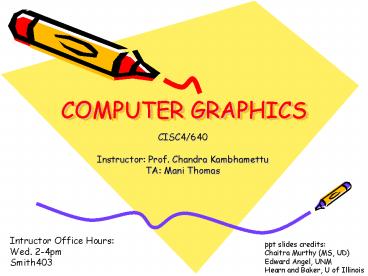COMPUTER GRAPHICS PowerPoint PPT Presentation
1 / 23
Title: COMPUTER GRAPHICS
1
COMPUTER GRAPHICS
- CISC4/640
- Instructor Prof. Chandra Kambhamettu
- TA Mani Thomas
Intructor Office Hours Wed. 2-4pm Smith403
ppt slides credits Chaitra Murthy (MS,
UD) Edward Angel, UNM Hearn and Baker, U of
Illinois
2
INTRODUCTION
- COMPUTER GRAPHICS
- IMAGE PROCESSING
- COMPUTER VISION
- gtgtgtGraphics Timeline
3
COMPUTER GRAPHICS
- Computer graphics is concerned with all aspects
of producing images using a computer - It concerns with the pictorial synthesis of real
or imaginary objects from their computer based
models - BACK
4
IMAGE PROCESSING
- Image processing is the converse process of
computer graphics. Image processing and
Understanding areas concentrate on analysis and
reconstruction of 2D or 3D objects from their
pictures - BACK
5
COMPUTER VISION
- Computer vision further more extends research
into understanding images. It is the construction
of explicit, meaningful descriptions of physical
objects from images. - BACK
6
GRAPHICS TIMELINE
- THEN
- The field humbly began 50 years ago with a few
lines on a cathode ray tube. - Until early 1980s it was a small specialized
field due to expensive hardware and software
(application programs)
7
GRAPHICS TIMELINE
- Now
- We can generate images almost indistinguishable
from photographs - Interactive.highly interactive!! In present
times user controls the contents, structure and
appearance of objects by using various input
devices
8
GRAPHICS TIMELINE
- Now (continued)
- Direct manipulation is in heavy use
- We can make feature-length movies entirely by
computer - On the whole, the development of computer
graphics is driven both by the needs of the user
community and by the advances in hardware and
software
9
POPULARITY
- why is it so popular
- -A picture is worth a 10000 words!!!!!
- It provides the most natural means of
communicating with a computer, since our
perception abilities are better with pictures
than with words - It is one of the rare fields that has many
commercial interests as there are research
interests - (Thanks to Hollywood!!)
10
APPLICATIONS
- Computer graphics is so much in demand because of
its limitless variety of applications - Display Of Information
- Medium to convey information
- Design
- Many applications exist in engineering and
architecture (CAD,VLSI) - Simulation
- Graphical flight simulators, games, commercials
and educational software - User Interfaces
- Visual paradigms in user interaction windows,
icons, menus etc. - Virtual Reality Applications
11
Wooden Mirror (D. Rozin, NYU)
- Sitting
- Movie
- Hand-still
- The wooden mirror has 830 pieces of wood each
about 40 mm square arranged into an octagon of
(170cm X 203cm X 25cm). - Each piece of wood is connected to a servo motor
that can tilt it about 30º up and down. - The whole piece is lit from above with a few spot
lights, in a way that when the pieces are tilted
upwards they become brighter, and when they tilt
downwards they become darker. The servo motors
can position each piece in 255 positions
theoretically yielding 255 gray levels per piece.
- In the center of the Mirror a tiny video camera
is concealed.
12
shinyballsmirror
- Shinyballsmirror Image
- Movie
13
Animation
- Fish
- Wind
- Cloth
- Terraexplorer
14
Image Creation
- Camera is used to take an image, stored on the
film. - Film records sample of intensity that hits each
point - Intensity is brightness of a point (amount of
light reflected off the point), usually measured
in lumens. - Intensity is discretized to pixel values
(continuous -gt discrete)
15
Images..
- CAMERA
- Light rays come through lens in the camera and
hits the film. - Proportion of light that hits the film is
controlled by the aperture (adjusted in
combination with the focal length). - Time duration (to keep the door open for light to
come-in) is controlled by shutter speed. - Us
- Light from the outside world excites nerves in
our retina and brain understands the stereo
images of our retina.
16
Discrete vs. Continuous worlds
- Computers are in discrete world, so we break the
continuous domain (time and space) into discrete
domain. - Animation 24 to 30 frames per second
- Image small dots making up a matrix for the
display. The small dots are Gaussian, called
pixels. - Value given to each pixel is called intensity.
17
Elements of Image Formation
- Objects
- Viewer
- Light source(s)
- Attributes that govern how light interacts with
the materials in the scene
18
Light
- Light is the part of the electromagnetic spectrum
that causes a reaction in our visual systems - Generally these are wavelengths in the range of
about 350-750 nm (nanometers) - Long wavelengths appear as reds and short
wavelengths as blues
19
Ray Tracing and Geometric Optics
- One way to form an image is to
- follow rays of light from a
- point source finding which
- rays enter the lens of the
- camera. However, each
- ray of light may have
- multiple interactions with objects
- before being absorbed or going to infinity.
20
Three-Color Theory
- Human visual system has two types of sensors
- Rods monochromatic, night vision
- Cones
- Color sensitive
- Three types of cones
- Only three values (the tristimulus
- values) are sent to the brain
- Need only match these three values
- Need only three primary colors
21
Pinhole Camera
Use trigonometry to find projection of point at
(x,y,z)
xp -x/z/d
yp -y/z/d
zp d
These are equations of simple perspective
22
Synthetic Camera Model
projector
p
image plane
projection of p
center of projection
23
Global vs Local Lighting
- Cannot compute color or shade of each object
independently - Some objects are blocked from light
- Light can reflect from object to object
- Some objects might be translucent

